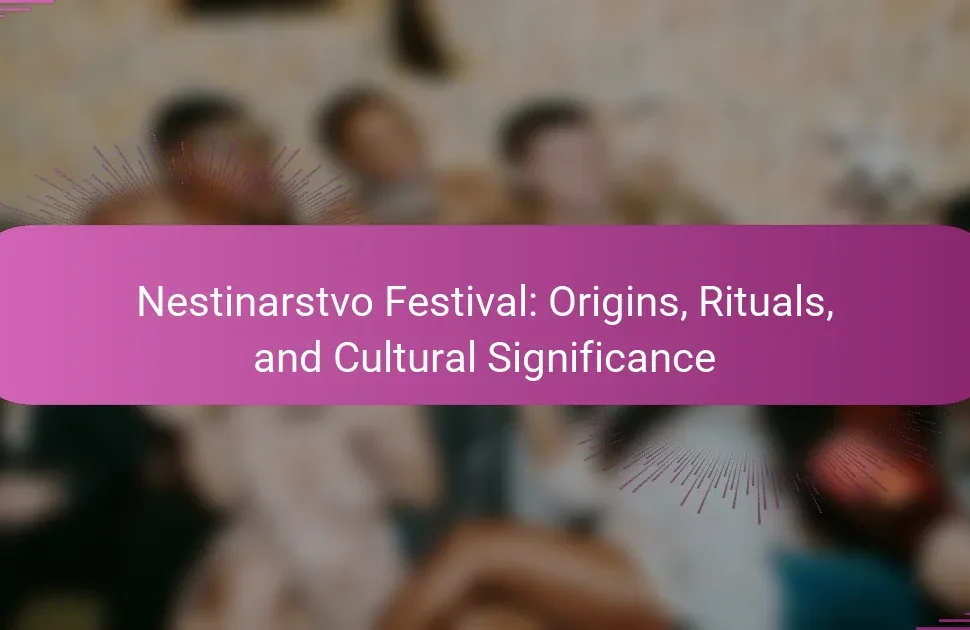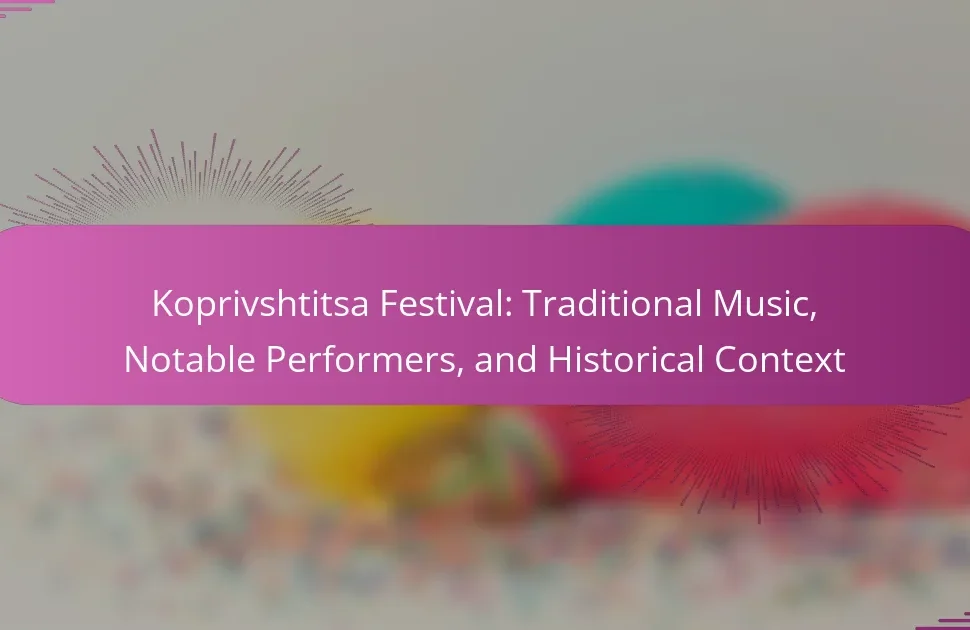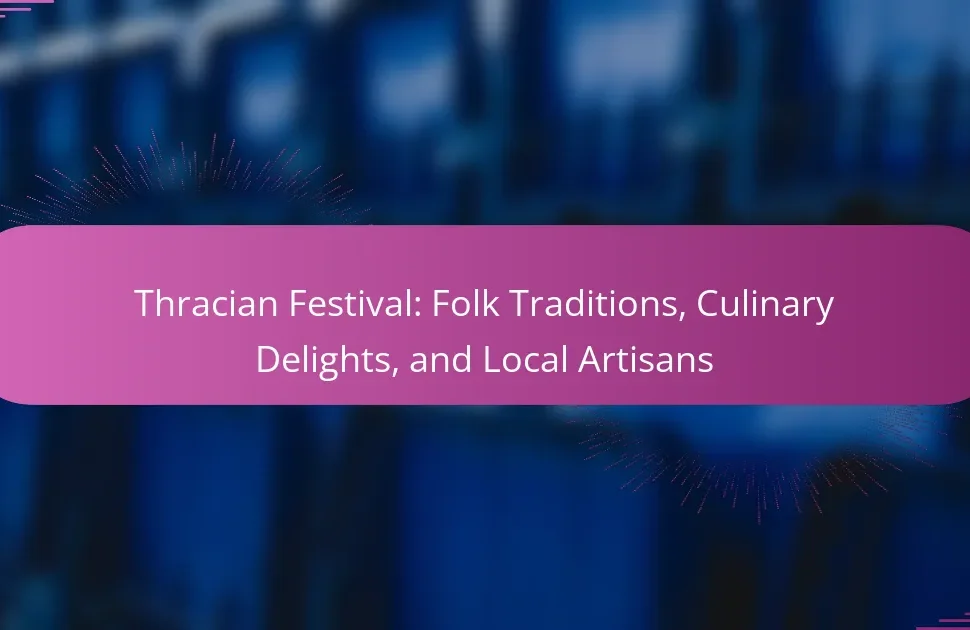Balkan Folk Music captivates with its distinctive rhythms and intricate melodies. This article explores its key characteristics, influential artists like Goran Bregović, and its global reach. Discover how regional variations reflect cultural identity and the genre’s impact on contemporary music. Engage with the vibrant traditions that keep Balkan Folk Music alive today.
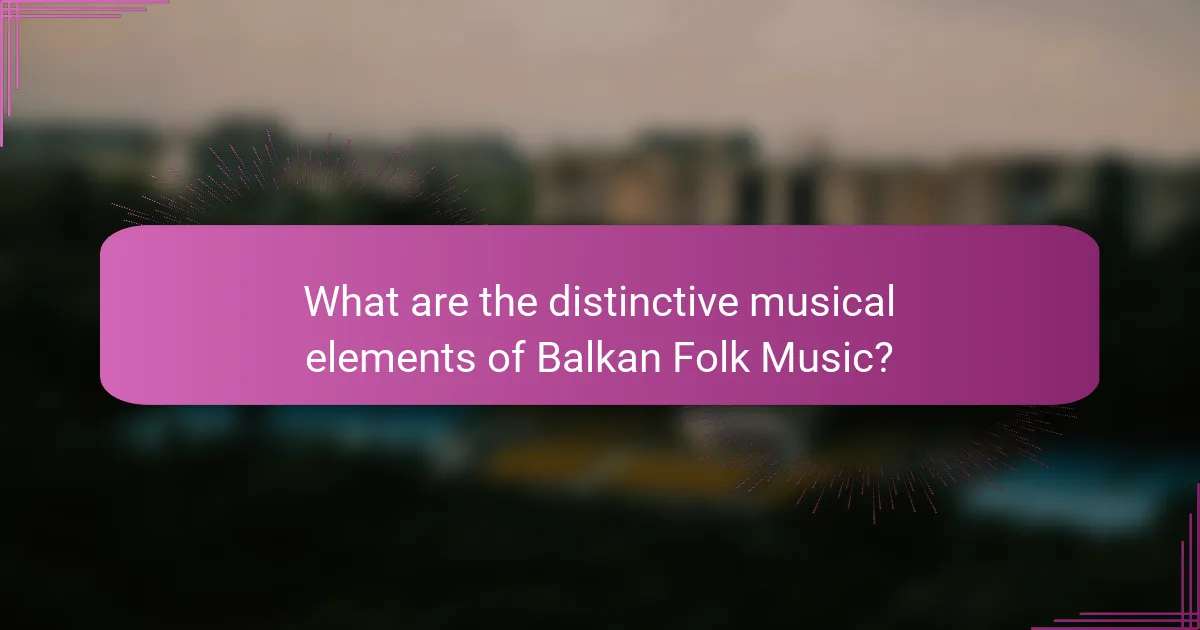
What are the distinctive musical elements of Balkan Folk Music?
Balkan Folk Music features distinctive rhythms, intricate melodies, and diverse instrumentation. Its unique time signatures, such as 7/8 and 9/8, create a characteristic sound. Instruments like the tamburica, kolo, and gaida enhance its cultural richness. Influential artists, such as Goran Bregović, have popularized these elements globally. The music’s emotional depth and communal dance traditions contribute to its enduring appeal.
How do rhythms and tempos define the genre?
Rhythms and tempos are essential in defining Balkan folk music, creating its distinctive sound. The genre is characterized by complex time signatures, such as 7/8 and 9/8, which contribute to its unique danceable quality. These irregular rhythms often evoke a sense of excitement and energy, making them integral to traditional performances. Influential artists like Goran Bregović and Fanfare Ciocărlia have popularized these rhythmic patterns globally, showcasing their cultural significance. The interplay of fast and slow tempos further enhances the emotional depth of the music, allowing for expressive storytelling through song.
Which instruments are commonly used in Balkan Folk Music?
Balkan folk music commonly features instruments such as the accordion, tamburica, gaida, and violin. These instruments create distinctive sounds that characterize the region’s rich musical traditions. The accordion adds depth, while the tamburica provides melodic lines. The gaida, a traditional bagpipe, contributes unique tonal qualities, enhancing the music’s cultural essence. The violin serves as a versatile instrument, often leading melodies in performances.
What role do vocals play in the music tradition?
Vocals are central to Balkan folk music, conveying emotions and storytelling. They serve as a primary means of cultural expression, often featuring intricate melodies and harmonies. The use of call-and-response patterns enhances community involvement, making performances interactive. Unique vocal techniques, such as throat singing, distinguish various regional styles, showcasing the diversity within the tradition.

Who are the influential artists shaping Balkan Folk Music today?
Prominent artists shaping Balkan Folk Music today include Goran Bregović, who blends traditional sounds with modern influences, and Hanka Paldum, known for her powerful vocals. Other influential figures are Šaban Šaulić, celebrated for his emotive performances, and the group Bistrik, which revitalizes regional folk traditions. These artists contribute to the genre’s global appeal, showcasing the rich cultural heritage of the Balkans. Their unique styles and innovative approaches help keep Balkan Folk Music vibrant and relevant in today’s music scene.
What contributions have traditional artists made to the genre?
Traditional artists have significantly shaped Balkan folk music through their unique styles and cultural expressions. Their contributions include preserving oral traditions and introducing innovative instrumentation. For instance, artists like Goran Bregović blend traditional melodies with contemporary elements, expanding the genre’s appeal globally. Moreover, the use of unique instruments, such as the tamburica, highlights the rich musical heritage of the region. The collaboration between traditional and modern artists has fostered a vibrant scene, ensuring the genre’s evolution while maintaining its roots.
How are contemporary musicians blending styles and influences?
Contemporary musicians blend Balkan folk music with various genres, creating innovative sounds. This fusion incorporates traditional instruments like the accordion and clarinet alongside modern elements such as electronic beats. Influential artists like Goran Bregović and Emir Kusturica showcase this blend, reaching global audiences. The unique rhythms and melodies of Balkan folk enhance genres like pop and rock, enriching the musical landscape.
Which festivals showcase prominent Balkan Folk Music artists?
Prominent Balkan Folk Music artists are showcased at festivals like the Guca Trumpet Festival, the Ohrid Summer Festival, and the International Festival of Folk Music in Romania. These events highlight traditional music, bringing together local and international talent. Guca, for example, is famous for its brass bands and lively atmosphere, attracting thousands of visitors annually. The Ohrid Summer Festival features a blend of music, including folk genres, set against a stunning lakeside backdrop. These festivals play a crucial role in preserving and promoting Balkan folk music globally.
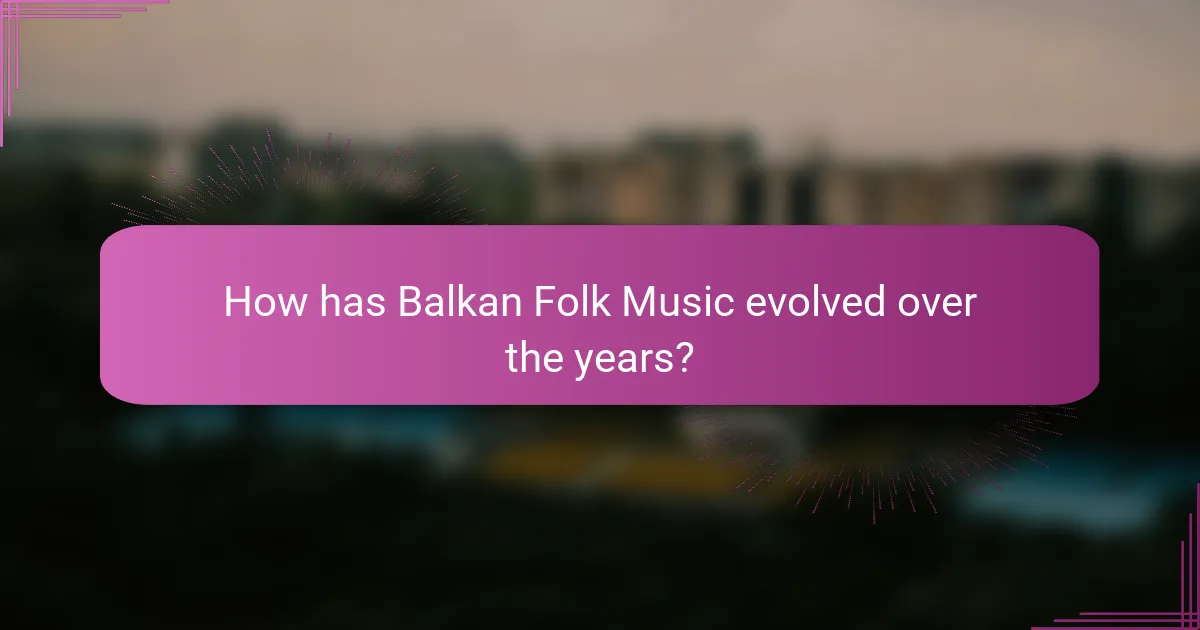
How has Balkan Folk Music evolved over the years?
Balkan Folk Music has evolved significantly, influenced by cultural exchanges and technological advancements. Traditional instruments like the tamburica and gaida have adapted, while new genres have emerged, blending folk with modern styles. Artists such as Goran Bregović have popularized Balkan sounds globally, showcasing the region’s rich musical heritage. The fusion of Balkan rhythms with contemporary music has expanded its reach, attracting diverse audiences.
What historical events have influenced its development?
Historical events such as the Ottoman Empire’s influence and the Balkan Wars significantly shaped Balkan folk music. The Ottoman rule introduced diverse musical traditions, blending local and Middle Eastern elements. The Balkan Wars and subsequent conflicts fostered a sense of national identity, leading to the preservation and revival of folk music in various countries. The fall of communism further allowed for a resurgence of traditional music, as artists sought to reconnect with their cultural roots.
How have cultural exchanges shaped the music?
Cultural exchanges have significantly shaped Balkan folk music by blending diverse musical traditions. The region’s history of migration and trade has introduced various instruments, rhythms, and melodies, enriching its sound. For instance, the incorporation of Ottoman, Slavic, and Romani influences has created a unique fusion that characterizes Balkan music today. This cross-cultural interaction has also facilitated the rise of influential artists who incorporate these diverse elements, allowing Balkan folk music to resonate globally. As a result, the music continues to evolve while maintaining its rich heritage.
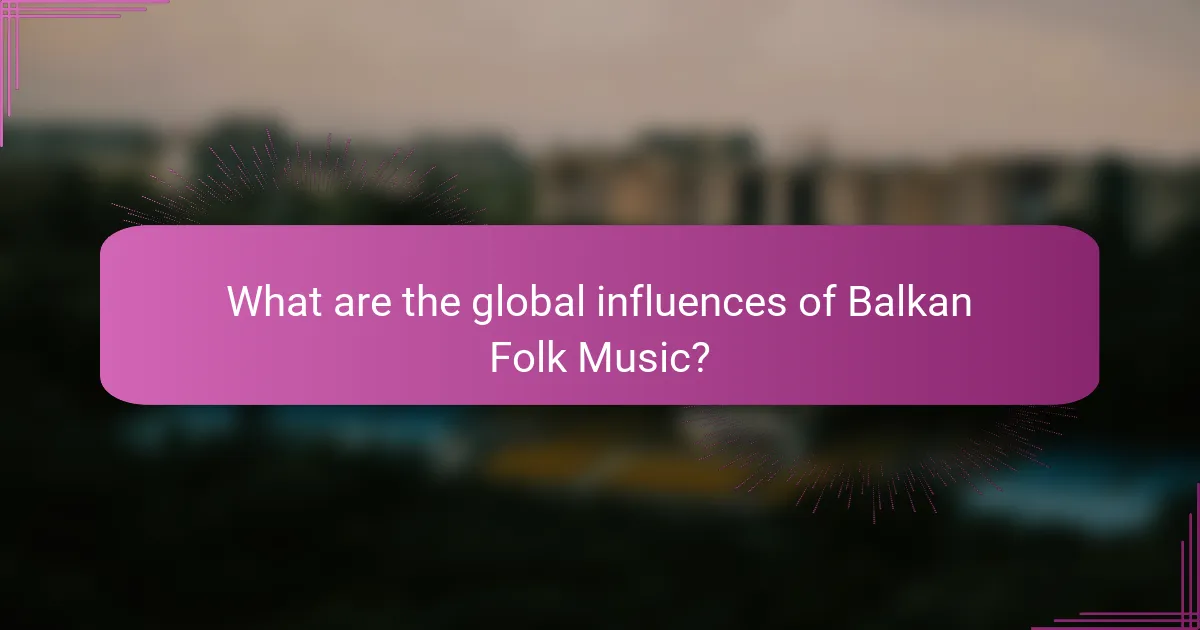
What are the global influences of Balkan Folk Music?
Balkan folk music significantly influences global music, blending traditional elements with contemporary styles. Its complex rhythms and rich melodies have inspired artists worldwide, fostering cross-cultural collaborations. Notable influences include the incorporation of Balkan scales in genres like jazz and electronic music, enriching global soundscapes. Furthermore, festivals celebrating Balkan music attract international audiences, promoting cultural exchange and appreciation.
How is Balkan Folk Music received in different cultures?
Balkan folk music is received with appreciation and curiosity across various cultures. Its unique rhythms and melodies resonate with diverse audiences, often blending into local music scenes.
In Western countries, Balkan folk music influences genres like world music and fusion, attracting listeners who seek authenticity. For instance, artists like Goran Bregović have gained international fame, showcasing traditional sounds in modern contexts.
In Eastern Europe, the music is celebrated as part of cultural heritage, often featured in festivals and community events. The vibrant dances and traditional instruments create a communal atmosphere that strengthens cultural identity.
Asian cultures, particularly in Turkey and Greece, recognize Balkan folk music’s historical connections, leading to mutual appreciation and collaborations. This cross-cultural exchange highlights the music’s adaptability and enduring appeal.
Which international collaborations have emerged from this genre?
Balkan folk music has led to numerous international collaborations, enriching global music scenes. Notable partnerships include collaborations between Balkan artists and musicians from genres like jazz, pop, and world music. These interactions have resulted in innovative blends, such as the fusion of traditional Balkan rhythms with contemporary styles, exemplified by bands like Fanfare Ciocărlia and their work with international artists. Additionally, festivals celebrating Balkan music often feature diverse lineups, encouraging cross-cultural exchanges that further broaden the genre’s reach.
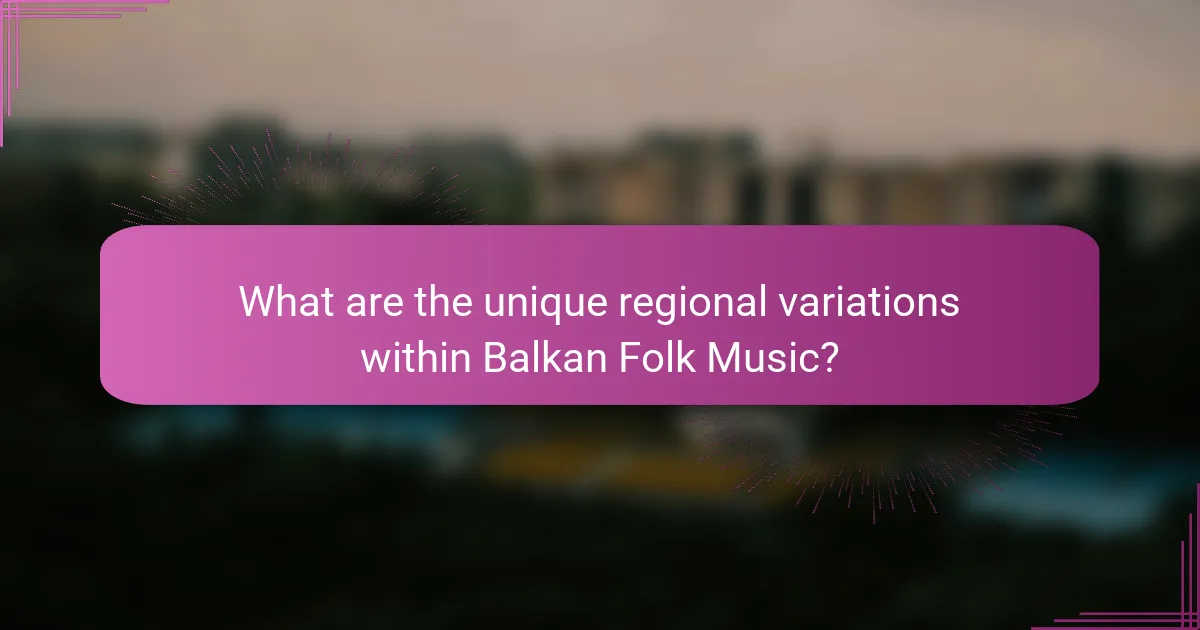
What are the unique regional variations within Balkan Folk Music?
Balkan Folk Music exhibits unique regional variations influenced by cultural history and geography. Each area, such as Serbia, Bulgaria, and Macedonia, showcases distinct instruments, rhythms, and vocal styles. For instance, Serbian music often features the accordion, while Bulgarian folk music is known for its complex vocal harmonies. The unique attribute of Macedonian music is the use of asymmetrical rhythms, setting it apart from its neighbors. These variations contribute to the rich tapestry of Balkan Folk Music, reflecting the diverse cultural identity of the region.
How do local traditions impact the sound and style?
Local traditions significantly shape the sound and style of Balkan folk music. Regional instruments, rhythms, and melodies reflect cultural heritage, creating distinct musical identities. For example, the use of the tamburica in Croatian music showcases unique tonal qualities, while Bulgarian folk songs often feature asymmetrical rhythms. These local elements contribute to the rich diversity of Balkan folk music, influencing both traditional and contemporary artists. The integration of local folklore and communal storytelling enhances emotional resonance, making the music a vital expression of identity.
Which rare instruments are specific to certain regions?
Certain rare instruments in Balkan folk music are unique to specific regions. The gaida, a type of bagpipe, is prominent in Bulgaria. The tamburica, a string instrument, is widely used in Croatia. In Serbia, the frula, a wooden flute, holds cultural significance. Each of these instruments reflects the distinctive musical traditions of their respective areas.

What practical tips can enhance the appreciation of Balkan Folk Music?
To enhance appreciation of Balkan Folk Music, engage with local communities, attend live performances, and explore traditional instruments. Listening to influential artists like Goran Bregović can deepen understanding of the genre’s key characteristics. Participating in workshops and learning folk dances fosters a personal connection to the music. Finally, exploring the global reach of Balkan Folk Music through online platforms can broaden perspectives and appreciation.
How can listeners engage with the music more deeply?
Listeners can engage more deeply with Balkan folk music by immersing themselves in its rhythms and cultural context. Exploring the history behind the music enhances appreciation. Attending live performances allows for a visceral connection with the artists. Learning traditional dances can provide a physical expression of the music’s energy. Additionally, studying the instruments used, such as the tamburica or gaida, reveals unique sounds that define the genre. Engaging with the lyrics, often rich in storytelling, fosters a deeper emotional connection to the music.
What common mistakes should newcomers avoid when exploring the genre?
Newcomers should avoid oversimplifying Balkan folk music, neglecting its cultural context, and ignoring diverse regional styles. Understanding the intricate rhythms and unique instruments is essential for appreciation. Engaging with influential artists enhances the listening experience and fosters a deeper connection to the genre.

